Freshwater-class ferry
The Freshwater class is a class of ferry operating the Manly ferry service between Circular Quay and Manly on Sydney Harbour. The ferries are owned by the Government of New South Wales and operated by Transdev Sydney Ferries under the government's Sydney Ferries brand.
 Collaroy in 2008 | |
| Class overview | |
|---|---|
| Builders | Carrington Slipways Newcastle |
| Operators | Transdev Sydney Ferries |
| Preceded by | Dee Why class, Binngarra |
| Completed | 4 |
| Active | 2 |
| Laid up | 2 |
| General characteristics | |
| Displacement | 1,140 tons (loaded) |
| Length | 70.4 m (231 ft 0 in) |
| Beam | 13.06 m (42 ft 10 in) |
| Draught | 3.35 m (11 ft 0 in) |
| Decks | 2 |
| Propulsion | 2x feathering propellors. One on each end. |
| Capacity | 1,100 |
| Crew | 6 |
| Notes | Double ended single hull of welded steel construction. Welded aluminium alloy superstructure. |
History
The need for new ferries on the Manly–Circular Quay service was identified during the mid-1970s, during which time the service was characterised by deteriorating quality and low patronage.
Decline of the Manly ferries
Prior to 1971, the ferry services on the Manly–Circular Quay route were operated by the Port Jackson & Manly Steamship Company. In that year, the company posted a modest profit of $112,000. Patronage was approaching all-time lows, but the growth prospect for ferry services was considered strong. In November 1971, the company attracted a $1.5 million takeover bid from diversified transport company Brambles Industries. The initial bid was rejected, but a later offer of $2.1 million was accepted.[1]
When Brambles took over, the Manly fleet consisted of four ferries: South Steyne, North Head, Bellubera and Baragoola, plus hydrofoils Manly, Fairlight and Dee Why. Almost immediately, the hydrofoils were sold to Waltons Finance and leased back. The four ferries were all ageing and expensive to maintain, and it soon became evident that Brambles intended to close the service or sell the ships to the State Government at the earliest opportunity. Fare increases and service suspensions followed. The Bellubera was withdrawn from service on 14 December 1973; the Baragoola was to follow early the next year. Public outrage and fears that the service would be suspended entirely led to the government resuming responsibility for the operation of the ferries in February 1974.[1]
Concerns about the on-going serviceability of the existing vessels led to a decision to modify the design of the Lady Wakehurst and Lady Northcott, then under construction for use on the inner harbour routes, so that they could be used as relief boats on the Manly run. On 27 August 1974 the public timetable was reduced to only require two ships. The decision to modify the two Lady-class vessels proved fortuitous; as both the North Head and the Baragoola had to be sent for major overhauls, and the smaller ferries acted as relief ships while these works were carried out.
During the naming ceremony for the Lady Northcott on 11 February 1975, then Liberal Minister for Transport Wal Fife announced that two new ferries would be introduced to the Manly service within three years.[1]
The Burness Corlett report
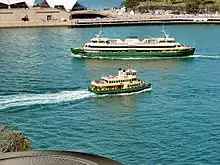
A study by maritime consultants Burness Corlett Australia was released in July 1976. It investigated the requirements of new vessels to replace the North Head and Baragoola by 1978. Various configurations were considered, including conventional monohull, catamaran, hovercraft and hydrofoil. Planing ferries of both single and twin-hull configuration were rejected, as such a configuration cannot be double-ended and therefore would have required berthing stern-first. Hydrofoils were also rejected from consideration due to excessive cost and limited passenger capacity. Two options were selected for detailed investigation: monohull and twin-hull, both double-ended and having 1,200 passenger capacity.[2]
Detailed designs and blueprints were prepared for both options. The study recommended the selection of the twin-hull due to the higher service frequency achievable (due to the twin-hull's faster speed of 18 knots, 33 km/h, 21 mph versus 14.5 knots, 26.9 km/h, 16.7 mph), however the study noted that other than this, there was relatively little difference between the options. The twin-hull was designed with dimensions of 63-metre (206 ft 8 in) length, 12.8-metre (42 ft 0 in) beam, and 3.3-metre (10 ft 10 in) draft, while the monohull design was 67-metre (219 ft 10 in) length, 11.6-metre (38 ft 1 in) beam, and 4.27-metre (14 ft 0 in) draft. The wider beam of the twin-hull design would exceed the limits of the existing wharves at Circular Quay, and necessitate a reconfiguration of the wharves if selected. Burness Corlett were confident that the twin-hull option was the superior choice, due to service speed and stability through Sydney Heads, and so no model tests were performed for the monohull design.[2]
Burness Corlett predicted that either design would take approximately 21 months to construct, and that if the new ferries were to be introduced in 1978 as planned, an aggressive construction program would have to begin immediately, with tenders to be called no later than April 1976 (the report was not even released until three months after this date).[2]
New ferries announced
After a change of government at the 1976 election, the new Labor government's Transport Minister Peter Cox announced that tenders would be called for the construction of a new "super ferry" in line with the results of the engineering study, to carry up to 1,200 passengers at speeds of 18 knots.
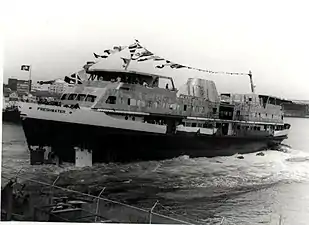
On 9 January 1978, the traditional three-ship Manly Ferry timetable was reintroduced. The service was operated with the Baragoola (1922), North Head (1913) and either the Lady Wakehurst or Lady Northcott. However, the modified Lady-class ships were not good substitutes for the two older vessels, as the newer Lady ferries were too small and too slow for the Manly service. Particularly the Lady-class ships were barely able to keep to the published timetable in peak hours. Following the return of the Labor Government at the State Election on 7 October 1978, the Labor Party's Alan Stewart became the Member for Manly. This provided a fresh political impetus for the State Labor administration to order the new Manly ferries.
Steelwork for Freshwater was laid down at the State Dockyard on 31 October 1980. Strike actions delayed completion until June 1982. The ferry terminals at Circular Quay and Manly were substantially modified to accommodate the larger ferries, including the installation of wide height-adjustable two-level hydraulic ramps.[3] Additionally a new bus-interchange was built in the wharf forecourt at Manly.
Proposed Retirement 2021–2023
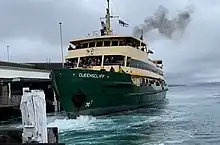
There were plans to replace the Freshwater-class ferries with three new Emerald-class catamaran ferries in 2021. In November 2020, the Minister for Transport announced that when the new ferries are put into operation, Collaroy would be retained in service until at least 2023 for weekend operation.[4] On 14 January 2021 it was announced that the Freshwater will also be retained for future services. The Queenscliff was retired on 13 October 2021, not long after the new Emerald-class vessels began operating.[5] On the 13th of June 2022 it was announced that Collaroy would be retired and replaced with Queenscliff instead. Along with this it was also announced that Narrabeen's engine rebuild has been cancelled. In August 2022, word spread about one ferry running a weekday service. This was confirmed with a new timetable coming into place on September 5, running one ferry every two hours. [6] After the 2023 New South Wales state election it was announced by new Transport minister Jo Haylen that she intends to return as many of the 4 Freshwater Class Ferries to full time service as possible. The maintenance required on Queenscliff, Narrabeen and Collaroy will ensure that the vessels will be able to operate for years to come. As for Freshwater her massive overhaul has allowed for years of service before another refit is required. As of right now there has been no estimated time frame for when the vessels will be ready to return to full service.
On September 27, 2023, Collaroy was retired and moved to Cockatoo Island the next day. Her last arrival into Circular Quay involved a ceremonious horn battle between Collaroy and the other vessels before she dropped off her final load and returned to Balmain one last time. The following day she was moved to Cockatoo Island to be stored alongside Narrabeen for long term storage.
Return to service 2023-2024
In April 2023 it was announced by new Transport minister Jo Haylen that she intended to return as many of the 4 Freshwater Class Ferries to full time service as possible. She intends to supply the vessels with the necessary maintenance required to return all 4 to full time service. Both Narrabeen and Queenscliff were left at Cockatoo island for around 2 years however as of writing Queenscliff is in the process of a refit with a second drydock in August required to return her to service. The Narrabeen has been collecting rust since its retirement in 2021. Narrabeen was intended to come back to service in 2022 after an engine rebuild however this was cancelled due to cost and time over runs. The Narrabeen is currently out of survey and lacks an engine meaning of all 4 Freshwaters her maintenance will be the longest and most costly. The Narrabeen will require a drydocking, a refit and an engine rebuild to return to service. Collaroy received a survey extension of 3 months in May 2023. Once Collaroy is out of survey she will require a drydocking and refit to return to service however this drydocking was put into doubt after it was announced that the Collaroy may not be able to return due to issues with receiving parts. Freshwater had a massive drydocking and refit in 2021 allowing the vessel to continue for at least 4 years before another large refit is required. Narrabeen is expected to return to service in the middle of 2024.[7]
Vessels
Freshwater
| Namesake | Freshwater Beach |
| Cost | $8.5 million[1] |
| Launched | 27 March 1982 |
| Completed | December 1982 |
| In service | 1983 |
| Identification |
|
| Status | In service |
MV Freshwater is the lead ship of the four Freshwater-class ferries.[8] It is named after Freshwater Beach on Sydney's Northern Beaches. It was launched on 27 March 1982 by Olive Cox and commissioned by her husband, Minister for Transport Peter Cox, on 18 December 1982.
The three-month old ferry ran aground at Manly Cove in March 1983 after overshooting the wharf following a computer failure.[9] On 30 March 1985, Freshwater was hijacked by a man who threatened to shoot passengers unless the captain piloted the ferry beyond Sydney Heads into the ocean. The hijacker was subdued after a police officer boarded the vessel and fired three warning shots. It turned out that the man, a New Zealander, had not been carrying a gun, but an empty vodka bottle (the second of two that he had consumed before boarding the vessel) concealed under his jacket. After a short jail sentence, the man returned to New Zealand in January 1986 by stowing away on the Oriana, for which he was also fined.[10][11][12]
While there were plans to retire the ship by 2021, a decision was made to keep Freshwater and Queenscliff operating, with Narrabeen and Collaroy to be retired.[6] However in 2023 after the 2023 New South Wales state election the current plan is to return this vessel along with its sisters to full time service.
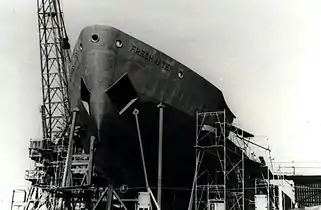 Under construction, NSW State Dockyard October 1981
Under construction, NSW State Dockyard October 1981 Launched, 27 March 1982
Launched, 27 March 1982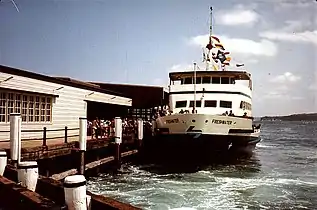 On her first run to Manly, 18 December 1982
On her first run to Manly, 18 December 1982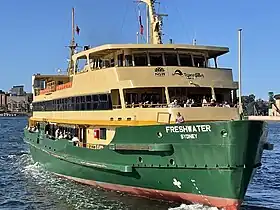 Freshwater departing Circular Quay in 2022. Her refit took place the previous year.
Freshwater departing Circular Quay in 2022. Her refit took place the previous year.
Queenscliff
| Namesake | Queenscliff Beach |
| Cost | $8.5 million[1] |
| Launched | 1983 |
| In service | 9 July 1983 |
| Identification |
|
| Status | Under refurbishment [6] |
MV Queenscliff is the second of the four Freshwater-class ferries to enter service. It is named after Queenscliff Beach on Sydney's Northern Beaches. It was to be retired, operating its final service on 13 October 2021.[13] However on the 13th of June 2022 it was announced that the Queenscliff will be brought back in to service, after a refit, to replace the Collaroy due to steering problems. [6] The vessel will reenter full time service once its refit is complete. It will return in November 2023.
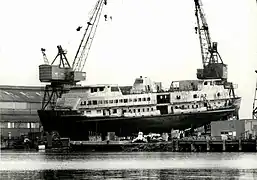 Under construction in Newcastle circa 1983
Under construction in Newcastle circa 1983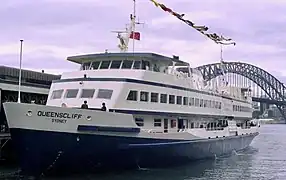 First day of service, 9 July 1983
First day of service, 9 July 1983 Queenscliff passing South Head, May 2020
Queenscliff passing South Head, May 2020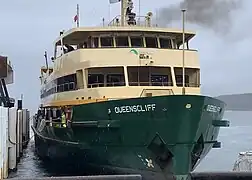 Queenscliff in 2021
Queenscliff in 2021
Narrabeen
| Namesake | Narrabeen Beach |
| Cost | $8.9 million[1] |
| Launched | 26 May 1984 |
| In service | 1984 |
| Identification |
|
| Status | stored at Cockatoo Island. Set to be refurbished and returned to service. |
MV Narrabeen is the third of the four Freshwater-class ferries to enter service. It is named after Narrabeen Beach on Sydney's Northern Beaches. Planned to be retired in 2021, On 9 December, it was announced that Narrabeen would get a new engine and continue service. However after much delay it was announced that the Narrabeen's engine rebuild was cancelled due to supply chain issues and expenses and the vessel was officially retired. However after the 2023 New South Wales state election new Transport minister announced the return of all 4 Freshwater Ferries meaning Narrabeen will receive the maintenance required for it to return to full time service.
She is the third Manly ferry to be called "Narrabeen". Narrabeen (I) was an 1886-built iron paddle-steamer that was hulked in 1917. Narrabeen (II) was built in 1921 and was the last of the Manly cargo ferries. She was sold out of the Manly run in 1928 and wrecked in 1958.
 Narrabeen during fitting out in 1984.
Narrabeen during fitting out in 1984.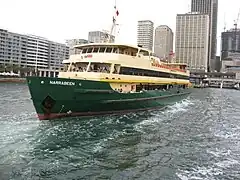 Narrabeen at Circular Quay in 2011.
Narrabeen at Circular Quay in 2011.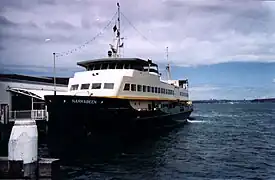 Narrabeen in Manly in 1990.
Narrabeen in Manly in 1990. MV Narrabeen berthed next to MV Queenscliff at Balmain shipyard after the 2 vessels were taken out of service in 2021.
MV Narrabeen berthed next to MV Queenscliff at Balmain shipyard after the 2 vessels were taken out of service in 2021.
Collaroy
| Namesake | Collaroy Beach |
| Cost | $12 million[1] |
| Launched | 21 August 1988 |
| In service | 1988 |
| Identification |
|
| Status | Retired 27th September, 2023 |
MV Collaroy is the final Freshwater-class ferry to enter service. It is named after Collaroy Beach on Sydney's Northern Beaches.
Collaroy differed from its classmates in having been equipped with underwater stabilisers and enhanced radar for use on ocean cruises.[14] The control systems were upgraded to match that being fitted during overhauls of the other Freshwater class. The Collaroy was also fitted with outdoor seating areas at each end of the upper deck which at the time was unique to the Collaroy. After this outdoor seating proved popular with passengers the other 3 Freshwater's were renovated to feature this outdoor seating in the early 2000s.
When Sydney hosted the 2000 Summer Olympics, Collaroy was the vessel used to carry the Olympic Flame across Sydney Harbour. In February 2001, Collaroy ran aground on Manly Point, putting the ferry out of service for several months and costing $2 million to repair.[15] Collaroy was originally meant to be retained along with MV Freshwater, operating on weekends and public holidays, however on the 13th of June 2022 it was announced that Collaroy would be retired and replaced with the recently retired MV Queenscliff after Queenscliff under goes a refit. [6] It was announced that the Collaroy may not return to service with her sisters due to difficulty obtaining parts for her. She was retired on September 27, 2023 with her future uncertain.
 Collaroy docked at the Overseas Passenger Terminal in 1991.
Collaroy docked at the Overseas Passenger Terminal in 1991. Collaroy under construction at Carington Slipways.
Collaroy under construction at Carington Slipways.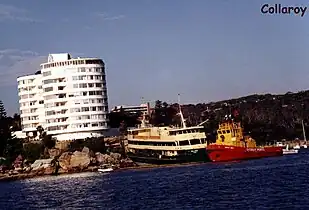 Collaroy aground near Kilburn Towers in Manly 2001.
Collaroy aground near Kilburn Towers in Manly 2001. Collaroy in 2008
Collaroy in 2008
References
- Tom Mead (1994). Manly Ferries of Sydney Harbour: The Seven Mile Ships. Sydney: Dolphin Books.
- Burness, Corlett Australia Pty. Ltd. (July 1975), Manly-Circular Quay Ferry Service - Type Optimisation and Preliminary Design Study for Public Transport Commission of N.S.W., Cremorne, NSW
{{citation}}: CS1 maint: location missing publisher (link) - Annual Report: 1980-81, Urban Transport Authority of New South Wales
- Future for Freshwater ferry secured Archived 27 November 2020 at the Wayback Machine Transport for NSW 27 October 2020
- Queenscliff had been in service for 38 years, just over half the time the previous Bingarra-class vessels operated (63 years). On 10 December 2021, it was announced that the Narrabeen would get an engine rebuild. It had been in storage since June of that year as its engine hours had expired and therefore, engine was in need of replacement. As of January 2022, the old engines have been removed and they have commenced work on the new ones. Sydney to retain second Freshwater ferry Archived 21 January 2021 at the Wayback Machine The Young Witness 15 January 2021
- "Steering dramas force government to recommission retired Manly ferry". 12 June 2022. Archived from the original on 12 February 2023.
- O’Rourke, Jim (4 April 2023). "Transport Minister reveals if iconic Manly ferries will return". dailytelegraph. Retrieved 22 May 2023.
- "Ferry Safety Investigation Report: Systemic Investigation Into Incidents of Collision Involving Freshwater Class Vessels Operated by Sydney Ferries Corporation" (PDF). Office of Transport Safety Investigations. 26 October 2006. Archived (PDF) from the original on 14 March 2018. Retrieved 3 March 2008.
- "Captain forced to ground vessel at Chowder Bay to avoid sinking after collision with collier". The Manly Daily. 11 March 2017. Archived from the original on 11 March 2017. Retrieved 10 November 2019.
- "Ferry highjacker was depressed, court told". Canberra Times. 2 April 1985. Archived from the original on 3 August 2016. Retrieved 18 May 2016.
- "Man charged over 'hijack' of ferry". The Age. 1 April 1985. Archived from the original on 5 April 2023. Retrieved 18 May 2016.
- "Happy homecoming for Kiwi Australia drove to drink". Canberra Times. 10 January 1986. Archived from the original on 22 August 2016. Retrieved 8 July 2016.
- "First Freshwater class Manly ferry retired". ABC Radio. 13 October 2021. Archived from the original on 20 October 2021. Retrieved 13 October 2021.
- MV Collaroy II ferriesofsydney.com
- "Captain forced to ground vessel at Chowder Bay to avoid sinking after collision with collier". The Manly Daily. 11 March 2017. Archived from the original on 11 March 2017. Retrieved 10 November 2019.